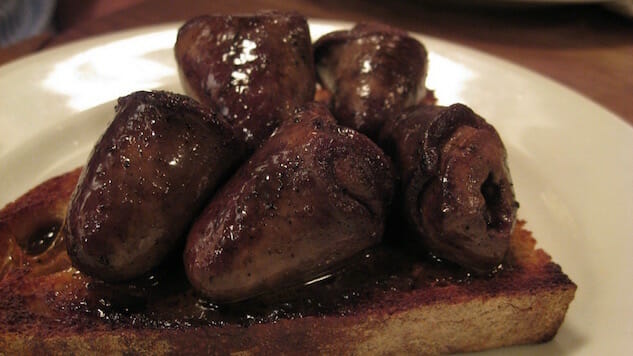Let’s Drink Beer and Eat Animal Hearts!
Photo Credit: Renee Suen
Hearts—be they fowl, bovine, or otherwise—are some of the most delectable, sought-after bits of offal to be found among gourmands, yet remain tragically underrated and under-appreciated by the general public. Most of this, it’s fair to assume has to do with the very nature of the cut with which we’re working; the heart has long been associated with love and love-related feelings, and we all probably feel sort of like monsters the first time we try them.
But they’re too delicious to ignore, and no one knows that better than Fergus Henderson, award-winning chef of London’s St. John, and all-around advocate and maestro of cooking nasty bits. In his book The Whole Beast, Henderson lays out a simple recipe for duck hearts on toast: fry five duck hearts in butter for about four minutes, add a splash of balsamic vinegar, plus dashes of sea salt and black pepper, and let simmer for a couple of minutes. Slap them on some toast and go to town.
Hearts—what with all the blood pumping through them and whatnot—retain a rich, iron-heavy flavor profile, and so you need a beer that is assertive enough to stand up to them, but with a cutting power to balance things out. In that case, a good Flemish red ale is a no-brainer: typically blends of sour brown ale aged in oak barrels for various lengths of time (sometimes over two years), they retain the maltiness of the base beer, but gradually take on tannic, wine-like properties that translate into notes of black cherry, leather, stone fruit, and occasionally port and chocolate.
Rodenbach is readily available and more than capable, but take a little more time and seek out Vander Ghinste Cuvée des Jacobins Rouge. Still fairly affordable at around $18 for a four-pack, this one is an unblended two-year-old ale aged in Bordeaux wine casks, and is my personal favorite. The malt profile locks onto the gamey characteristics of the duck hearts, while the acetic and fruit qualities help cut it; the splash of balsamic ties it all together.
Vietnamese Pho with Brasserie Vapeur Saison de Pipaix
If you give two shakes about Vietnamese food, you’ve had pho. A broth-based soup flavored with—among other things—lime, star anise, and ginger, it typically contains noodles, flank steak or another protein, and bean sprouts. But this is a piece about the stuff you never thought you’d eat if you weren’t under extreme duress, so it’s obviously not that simple.
Let me tell you about the Ha Long Bay Special Soup at Ha Long Bay here in Madison, Wisconsin. It hits all the marks of a traditional pho, but it contains a secret ingredient, and that secret ingredient is every part of the animal. Everything. Tripe (that’s the lining of the stomach), tendon, a meatball they say is pork but is probably only about half-right, and more. It’s amazing: salty, sour, rich, and fresh all at once, the dish highlights all the best characteristics of the tripe and tendon—no mere flavor sponges, they actually exhibit some great flavors—while minimizing the elements that, somewhat fairly, feed the stereotypes working against them.
For this dish, you need something suitably lively, a little spicy and, frankly, kind of wacky. Look no further than the superb Saison de Pipaix by Brasserie Vapeur. Slightly darker than most farmhouse ales, and stronger at 6% ABV, this saison also distinguishes itself by its use of some finicky yeast strains that throw off iron-like, wet wool types of flavors. These characteristics complement the riot of passion fruit, lemon peel, and floral hops layered throughout the beer as well.
Consumed together, the pho and saison complement each other beautifully: the savory, tart components of the soup are brought to the forefront, while the overly citrus-forward notes of the broth lend something of a tea-like flavor to the beer itself.
Fried Chicken Livers with Bell’s Cherry Stout
I know—I have to be kidding, right? Gamey, fatty organs with a fruit beer; it sounds like a troll job if ever there was one, and with most fruit beers—heck, with most cherry beers—you’d be justified in your skepticism. Hear me out…
-

-

-

-

-

-

-

-

-

-

-

-

-

-

-

-

-

-

-

-

-

-

-

-

-

-

-

-

-

-

-

-

-

-

-

-

-

-

-

-








































